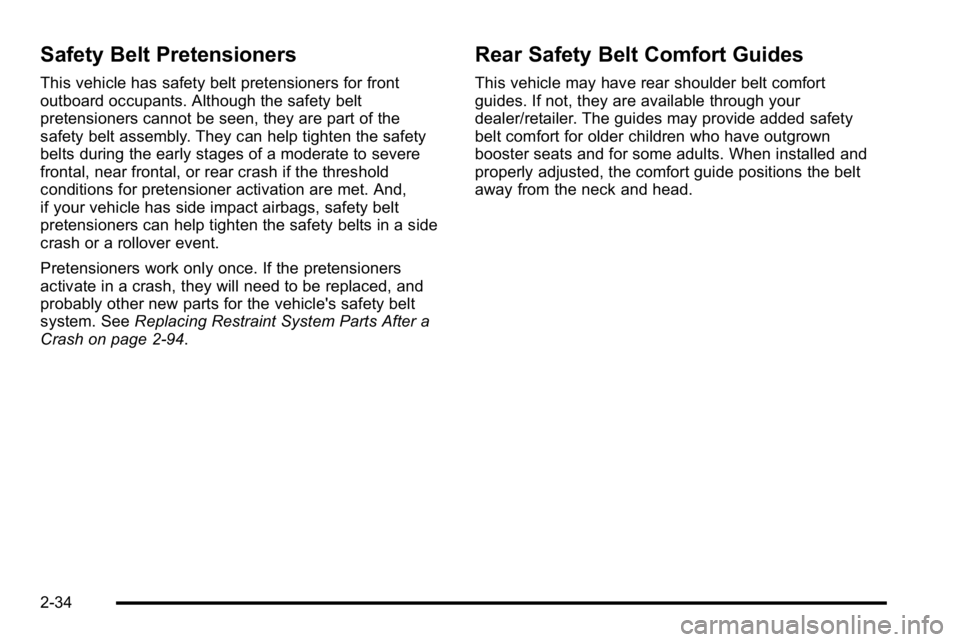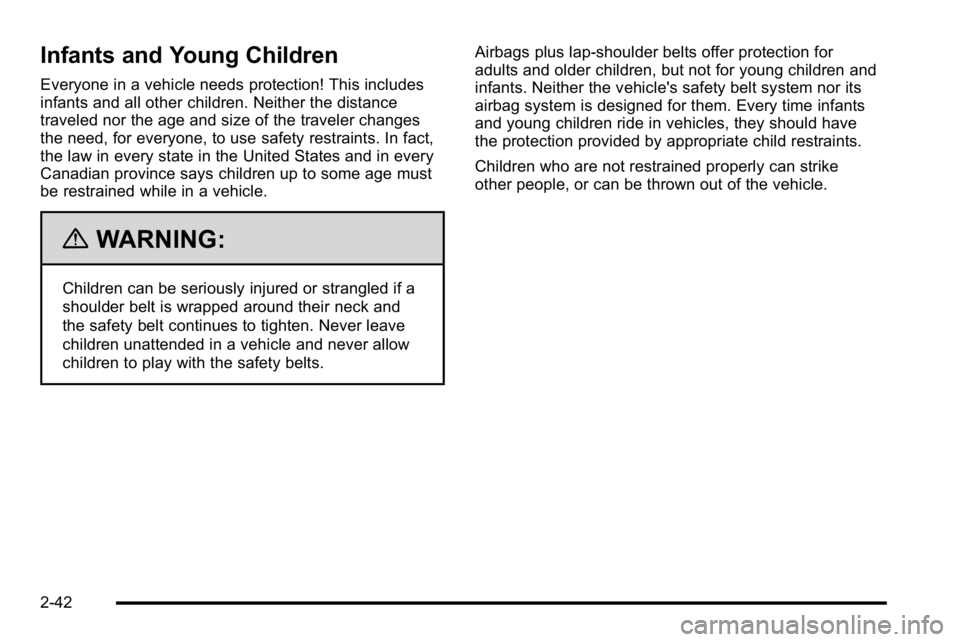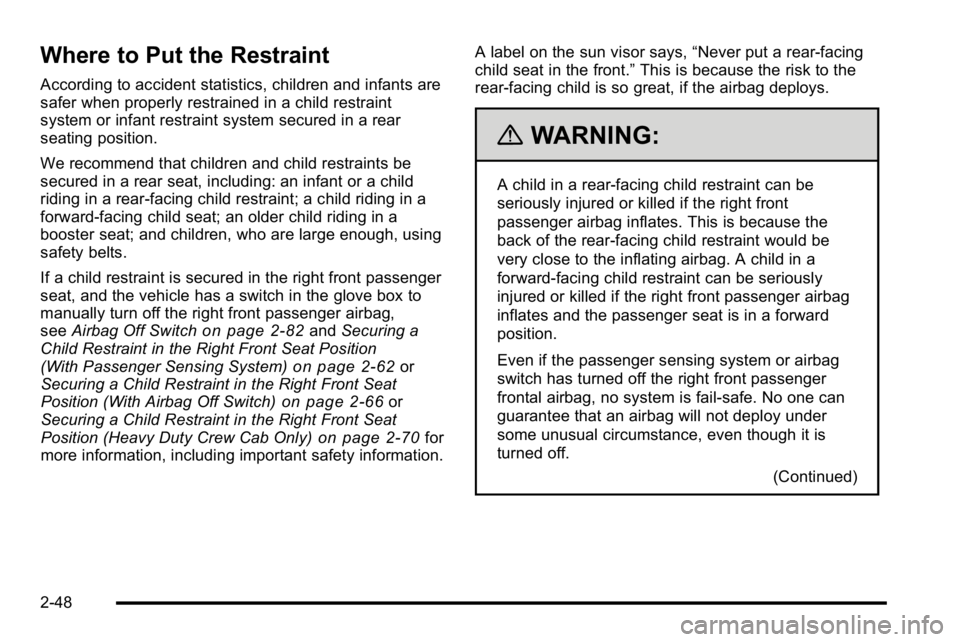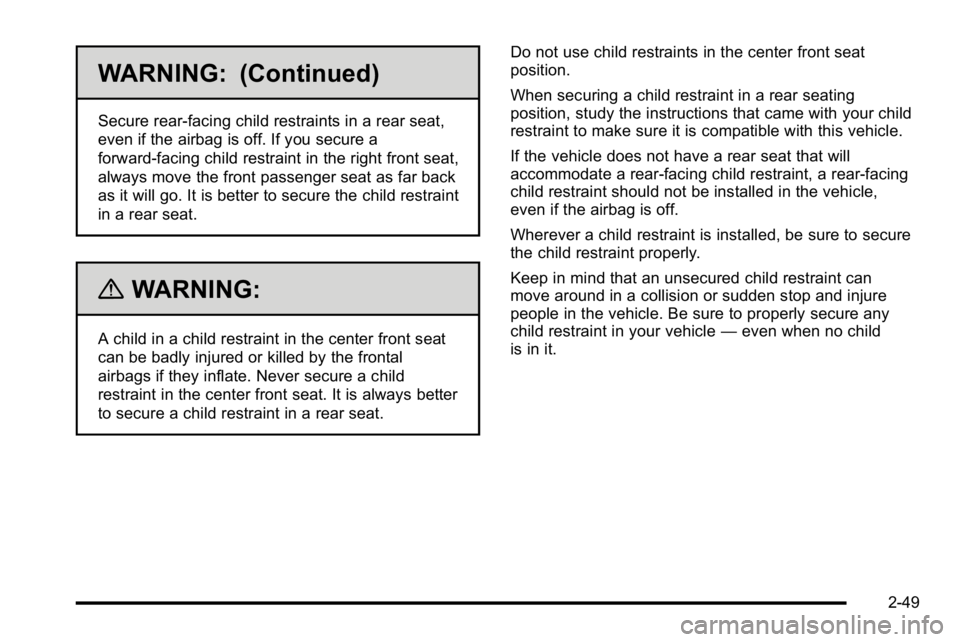Page 44 of 630

Section 2 Seats and Restraint System
Airbag System. . . . . . . . . . . . . . . . . . . . . . . . . . . . . . . . . . . . 2-73
Where Are the Airbags? . . . . . . . . . . . . . . . . . . . . . . . 2-75
When Should an Airbag Inflate? . . . . . . . . . . . . . . . 2-78
What Makes an Airbag Inflate? . . . . . . . . . . . . . . . . 2-79
How Does an Airbag Restrain? . . . . . . . . . . . . . . . . 2-79
What Will You See After an Airbag Inflates? . . . 2-80
Airbag Off Switch . . . . . . . . . . . . . . . . . . . . . . . . . . . . . . 2-82
Passenger Sensing System . . . . . . . . . . . . . . . . . . . 2-85
Servicing Your Airbag-Equipped Vehicle . . . . . . . 2-91
Adding Equipment to Your Airbag-Equipped Vehicle . . . . . . . . . . . . . . . . . . . . . . . . . . . . . . . . . . . . . . 2-91 Restraint System Check
. . . . . . . . . . . . . . . . . . . . . . . . .2-93
Checking the Restraint Systems . . . . . . . . . . . . . . . 2-93
Replacing Restraint System Parts After a Crash . . . . . . . . . . . . . . . . . . . . . . . . . . . . . . . 2-94
2-2
Page 62 of 630
or the safety belts!
With safety belts, you slow down as the vehicle does.
You get more time to stop. You stop over more distance,
and your strongest bones take the forces. That is why
safety belts make such good sense.
Questions and Answers About
Safety Belts
Q: Will I be trapped in the vehicle after a crash if Iam wearing a safety belt?
A: You could be—whether you are wearing a safety
belt or not. But your chance of being conscious
during and after an accident, so you can unbuckle
and get out, is muchgreater if you are belted. And
you can unbuckle a safety belt, even if you are
upside down.
Q: If my vehicle has airbags, why should I have to wear safety belts?
A: Airbags are supplemental systems only; so they
work withsafety belts —not instead of them.
Whether or not an airbag is provided, all occupants
still have to buckle up to get the most protection.
That is true not only in frontal collisions, but
especially in side and other collisions.
2-20
Page 76 of 630

Safety Belt Pretensioners
This vehicle has safety belt pretensioners for front
outboard occupants. Although the safety belt
pretensioners cannot be seen, they are part of the
safety belt assembly. They can help tighten the safety
belts during the early stages of a moderate to severe
frontal, near frontal, or rear crash if the threshold
conditions for pretensioner activation are met. And,
if your vehicle has side impact airbags, safety belt
pretensioners can help tighten the safety belts in a side
crash or a rollover event.
Pretensioners work only once. If the pretensioners
activate in a crash, they will need to be replaced, and
probably other new parts for the vehicle's safety belt
system. SeeReplacing Restraint System Parts After a
Crash on page 2‑94.
Rear Safety Belt Comfort Guides
This vehicle may have rear shoulder belt comfort
guides. If not, they are available through your
dealer/retailer. The guides may provide added safety
belt comfort for older children who have outgrown
booster seats and for some adults. When installed and
properly adjusted, the comfort guide positions the belt
away from the neck and head.
2-34
Page 84 of 630

Infants and Young Children
Everyone in a vehicle needs protection! This includes
infants and all other children. Neither the distance
traveled nor the age and size of the traveler changes
the need, for everyone, to use safety restraints. In fact,
the law in every state in the United States and in every
Canadian province says children up to some age must
be restrained while in a vehicle.
{WARNING:
Children can be seriously injured or strangled if a
shoulder belt is wrapped around their neck and
the safety belt continues to tighten. Never leave
children unattended in a vehicle and never allow
children to play with the safety belts.Airbags plus lap‐shoulder belts offer protection for
adults and older children, but not for young children and
infants. Neither the vehicle's safety belt system nor its
airbag system is designed for them. Every time infants
and young children ride in vehicles, they should have
the protection provided by appropriate child restraints.
Children who are not restrained properly can strike
other people, or can be thrown out of the vehicle.
2-42
Page 86 of 630
{WARNING:
Never do this.
Children who are up against, or very close to, any
airbag when it inflates can be seriously injured or
killed. Never put a rear-facing child restraint in the
right front seat. Secure a rear-facing child restraint
in a rear seat. It is also better to secure a
forward-facing child restraint in a rear seat. If you
must secure a forward-facing child restraint in the
right front seat, always move the front passenger
seat as far back as it will go.
Q: What are the different types of add-on childrestraints?
A: Add-on child restraints, which are purchased by the
vehicle's owner, are available in four basic types.
Selection of a particular restraint should take into
consideration not only the child's weight, height, and
age but also whether or not the restraint will be
compatible with the motor vehicle in which it will
be used.
2-44
Page 90 of 630

Where to Put the Restraint
According to accident statistics, children and infants are
safer when properly restrained in a child restraint
system or infant restraint system secured in a rear
seating position.
We recommend that children and child restraints be
secured in a rear seat, including: an infant or a child
riding in a rear-facing child restraint; a child riding in a
forward-facing child seat; an older child riding in a
booster seat; and children, who are large enough, using
safety belts.
If a child restraint is secured in the right front passenger
seat, and the vehicle has a switch in the glove box to
manually turn off the right front passenger airbag,
seeAirbag Off Switch
on page 2‑82and Securing a
Child Restraint in the Right Front Seat Position
(With Passenger Sensing System)
on page 2‑62or
Securing a Child Restraint in the Right Front Seat
Position (With Airbag Off Switch)
on page 2‑66or
Securing a Child Restraint in the Right Front Seat
Position (Heavy Duty Crew Cab Only)
on page 2‑70for
more information, including important safety information. A label on the sun visor says,
“Never put a rear-facing
child seat in the front.” This is because the risk to the
rear-facing child is so great, if the airbag deploys.
{WARNING:
A child in a rear-facing child restraint can be
seriously injured or killed if the right front
passenger airbag inflates. This is because the
back of the rear-facing child restraint would be
very close to the inflating airbag. A child in a
forward-facing child restraint can be seriously
injured or killed if the right front passenger airbag
inflates and the passenger seat is in a forward
position.
Even if the passenger sensing system or airbag
switch has turned off the right front passenger
frontal airbag, no system is fail-safe. No one can
guarantee that an airbag will not deploy under
some unusual circumstance, even though it is
turned off.
(Continued)
2-48
Page 91 of 630

WARNING: (Continued)
Secure rear-facing child restraints in a rear seat,
even if the airbag is off. If you secure a
forward-facing child restraint in the right front seat,
always move the front passenger seat as far back
as it will go. It is better to secure the child restraint
in a rear seat.
{WARNING:
A child in a child restraint in the center front seat
can be badly injured or killed by the frontal
airbags if they inflate. Never secure a child
restraint in the center front seat. It is always better
to secure a child restraint in a rear seat.Do not use child restraints in the center front seat
position.
When securing a child restraint in a rear seating
position, study the instructions that came with your child
restraint to make sure it is compatible with this vehicle.
If the vehicle does not have a rear seat that will
accommodate a rear-facing child restraint, a rear-facing
child restraint should not be installed in the vehicle,
even if the airbag is off.
Wherever a child restraint is installed, be sure to secure
the child restraint properly.
Keep in mind that an unsecured child restraint can
move around in a collision or sudden stop and injure
people in the vehicle. Be sure to properly secure any
child restraint in your vehicle
—even when no child
is in it.
2-49
Page 98 of 630

1. 3. Remove the cover to expose the anchor.
1. 4. Route, attach, and tighten the top tetheraccording to your child restraint instructions
and the following instructions:
If the position you are
using has an adjustable
headrest or head restraint
and you are using a dual
tether, route the tether
around the headrest or
head restraint .
If the position you are
using has an adjustable
headrest or head restraint
and you are using a
single tether, raise the
headrest or head restraint
and route the tether under
the headrest or head
restraint and in between
the headrest or head
restraint posts. 2. See
Securing a Child Restraint in the Right Front
Seat Position (With Passenger Sensing System)
on page 2‑62or Securing a Child Restraint in the
Right Front Seat Position (With Airbag Off Switch)
on page 2‑66or Securing a Child Restraint in the
Right Front Seat Position (Heavy Duty Crew Cab
Only)
on page 2‑70for instructions on installing
the child restraint using the safety belts.
3. Push and pull the child restraint in different directions to be sure it is secure.
Crew and Extended Cab Models
1. Attach and tighten the lower attachments to thelower anchors. If the child restraint does not have
lower attachments or the desired seating position
does not have lower anchors, secure the child
restraint with the top tether and the safety belts.
Refer to your child restraint manufacturer
instructions and the instructions in this manual.
1. 1. Find the lower anchors for the desired seating position.
1. 2. Put the child restraint on the seat.
1. 3. Attach and tighten the lower attachments on the child restraint to the lower anchors.
2-56